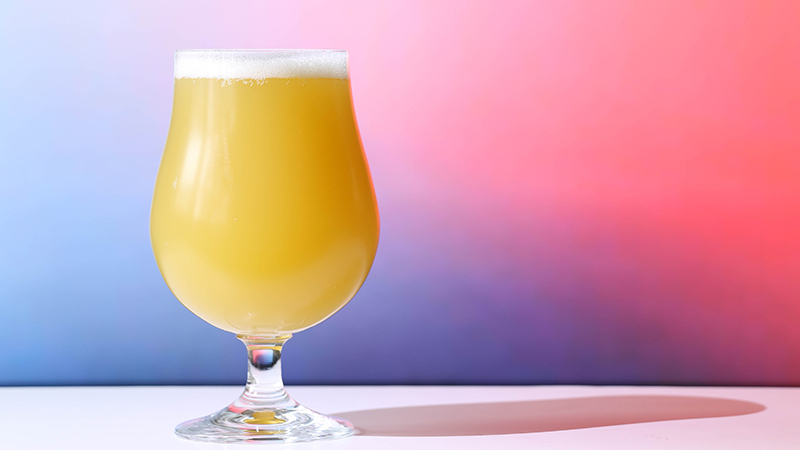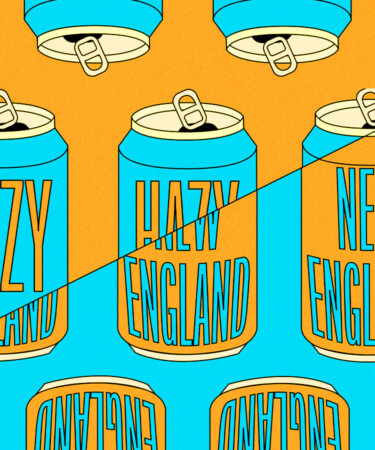Juice bombs, hazy IPAs, New England IPAs — no matter what you call them, these dank, hop-saturated, cloudy brews are here to stay. And with so many of them on the shelves sporting wild can art, long lists of every hop combo imaginable, and a rotating arsenal of buzzwords to describe their inherent “juiciness,” some of the terminology associated with this style can be a bit confusing. The titles hazy IPA and New England IPA seem to be interchangeable, but it’s really a square-rectangle situation. Virtually all New England IPAs (NEIPAs) are hazy, but not all hazy IPAs are New England IPAs. When it comes to differentiating between the terms, it’s all a matter of marketing.
“Hazy IPA is used to describe what many in my region (the Northeast) would call a NEIPA,” says Andrew Luberto, Northeast rep for the Beer Judge Certification Program (BJCP). “The BJCP guidelines under Hazy IPA specifically state, ‘Also known as New England IPA or NEIPA.’ So, these are not two distinct styles, just a difference in regional recognition of origin versus national marketing.”
Since the style has become so popular throughout the country, a lot of American breweries outside the Northeast feel the need to label their hazy offerings as “New England-style” or “hazy.” This is perhaps why Sierra Nevada, king of the old-school, caramel-tone West Coast IPA, releases any New England-style brews as part of its “Hazy Little Thing” line.
Vermont-based brewery The Alchemist is generally credited for coining the style with Heady Topper, a famous double IPA that kicked off the haze craze in the early 2010s. Though some would argue that Heady is not as hazy or fruit-forward as a lot of other modern New England IPAs, its opaque appearance and subtle bitterness are undoubtedly characteristic of the NEIPA profile. Funny enough, many legendary breweries in the Northeastern United States take a humble approach to marketing their hazy or New England-style IPAs, often leaving those buzzwords out of their branding. Like the Alchemist, Massachusetts-based Treehouse Brewing Company only lists its hazies as pale ales, American IPAs, or double IPAs, with the differences among those categories dictated solely by each beer’s ABV. It’s therefore almost a given that any IPA made in New England will be hazy, whether or not the words “hazy” or “New England” show up anywhere on the can or bottle. In fact, the use of ”hazy” as a marketing term is starting to dwindle in popularity, even in other parts of the nation.

Monkish Brewing Co. in Los Angeles is widely famous for its hazy IPAs, often mentioned in the same breath as Tree House, Trillium, and other giants hailing from the Northeast. Monkish, too, only advertises its NEIPAs as either IPAs, double IPAs, or triple IPAs with no mention of their creamy haze. This could suggest that advertising a beer as “hazy” or “New England-style” is becoming passé in today’s beer scene. It’s as if the haze factor is now a given whenever IPAs are in question.
Ironically, despite predating hazies, traditional West Coast IPAs have become the new novelty in today’s beer marketing. Since hazies and New Englands have become so commonplace, “West Coast” tends to be a more frequent distinction in beer packaging these days. In a way, the style now indicates a brewery stepping out of its comfort zone or trying something unconventional.
So when buying an IPA in 2023, it’s almost always going to be some rendition of juicy, tropical, hoppy haze, whether or not it’s dubbed “hazy” or “New England” style. As for the pine-forward, crystal-clear amber brews à la Sierra Nevada and Russian River Brewing, you’re more likely to see them marketed specifically as “West Coast” IPAs.
